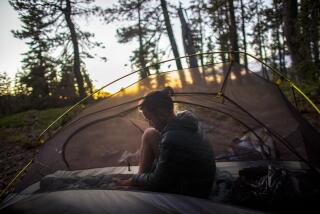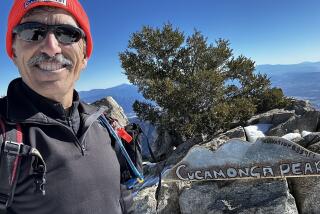Proper use of forks
You’re going along a trail and suddenly it forks, but that doesn’t jibe with what’s on your map. Take a wrong turn and it could mean a long detour or worse, a search-and-rescue operation.
Which way to go?
Even the savviest navigators sometimes get off track. Knowing how to read maps and use a compass will help you find your way, but staying on course over shorter distances involves using something even more elementary -- your noggin.
“The most important thing in navigation is using your head -- your noodle,” says Marc Hertz, an instructor with the Sierra Club’s wilderness travel course.
Students are schooled in all the minutiae of navigating a trail, from deciphering the squiggles of a topographic map to shooting a compass bearing.
To graduate from the course, would-be Magellans have to successfully complete a “nav noodle,” a series of route-finding scenarios set up by instructors to test map and compass skills.
“The single most important thing to being a good navigator is terrain association,” says Darran Wells, a land navigation instructor at the National Outdoor Leadership School in Lander, Wyo., who is writing a book on the subject.
Wells says he notices that students stare at maps and compasses when they should be looking at the land around them and making mental notes about hills and valleys and the creeks they cross.
A basic tip Wells gives for staying on course is to turn around and look back at the path so you’ll recognize it when walking or riding on the way back. Identifying primary trails should be pretty easy because they tend to be well worn and wider than side trails.
People often get lost by turning off main trails at a switchback, ending up on faint trails that wildlife use, Wells says.
Be aware of changes in a trail; if it starts to narrow drastically or becomes very brushy, chances are you took a wrong turn.
Another trick to help guide the way is to create a series of “handrails” that parallel a trail. Handrails can be natural land forms, such as ridgelines and creeks, or such man-made objects as power lines and off-road trails.
You can add “backstops,” such as a chain of mountains or a body of water, that will help you know when you’ve gone too far.
If a trail peters out or you suddenly realize you’re not on the right trail, Hertz recommends moving to higher ground. Getting above the trail gives you a better vantage point to see which direction the trail goes.
If a lake is your destination, pay attention to which way streams are flowing, advises Laura Konda, a California Department of Fish and Game staffer who teaches fellow employees how to use the global positioning system. The lake you’re heading to is probably the stream’s source.
One of the easiest ways to stay on your route is to know which way is north. “A good navigator will be able to do that without a compass at all, by using the sun and looking at land features,” says Wells.
One trick to finding north is to use a perfectly straight tree as a sundial. At midday in the Northern Hemisphere, the shadow of a straight tree will point north, he says. If heading north, you’ll be stepping on your shadow.
Trail users can also use man-made objects to stay the course. Those upside-down exclamation points on trees aren’t satanic symbols left behind by the film crew of “The Blair Witch Project.” They’re blazes carved by land managers to help mark a trail.
Rock pyramids called cairns or ducks stacked by trail managers or other hikers also can guide the way. Go ahead and build your own to mark a little-used trail, Wells says, but make sure to disassemble them on your way out to avoid confusing others.
Beware of relying too heavily on ducks left by others; those stones aren’t necessarily following your route and may lead you far afield.
As for those confusing forks in the path, it helps to check a detailed topographic map frequently and always know where you are on the trail. Wilderness travel course students are taught to take compass bearings to verify their locations at several points on a hike.
As Hertz says, “If you always know where you are, it’s much more difficult to get lost.”
To e-mail Julie Sheer or read her previous Outdoors Institute columns, go to latimes.com/juliesheer.


